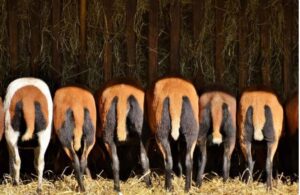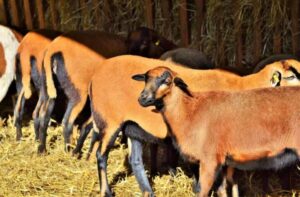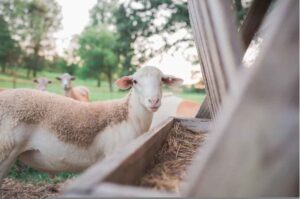Zero Grazing Sheep Farming: The sheep in the extreme group were raised in an enclosed shed with a 1 m2 animal floor space. Fodder and water were handled hygienically under the zero-grazing system. A practice known as zero grazing involves cutting fresh hay each day and feeding sheep. It enables farmers without sheep grazing infrastructure to use fresh grass and enhance milk output from grass/forage. Additional fresh grass feed can assist lower feed expenses, especially when milk prices are low. Let us learn more about sheep farming with zero grazing.

Zero grazing may also be an option while grazing on extremely wet pastures, provided that the used equipment has wide enough wheels to safely disperse its load. For a Zero grazing system to work, grassland management flexibility and expertise are required, as is access coverage. The sheep in the severe group were raised in a covered shed that had a 1 m2 animal floor space. The Zero grazing system controlled fodder and water in a hygienic manner. This group had adequate arrangements for food and water.
The animals were relocated to a night shelter in the large system, a shed covered with 1 m2 of animal floor area. Too many sheep farmers have a strict no-grazing policy and closely regulate the sheep’s food. About 30,000 well-bred sheep are present. Semi-intensive is the term used to describe the two together. The majority of the country’s semi-intensive care facilities are in the north, where 40,000 sheep are thought to be present.
Benefits of Zero grazing sheep farming
The farming method known as “Zero grazing” is gaining popularity every day. It is a novel approach that has numerous benefits over conventional sheep ranching. Some of the key advantages of a zero-grazing sheep farming method include high profitability, quick development, little maintenance, etc. The efficiency of the sheep farming sector has increased because to technological advancements, particularly for intensive farmers. Recent years have seen a marked improvement in milk facilities, and computerized data collection has further aided in market expansion and farm management. The advantages are;
- Increased use of grass
- A wet farm’s flexibility may allow for the early-season inclusion of grass in the feed.
- improved access to grass, such as in fields where it is difficult or too far for sheep to travel.
- Given the high animal efficiency compared to the continuous silage of hay throughout the season, you can keep more sheep on a given amount of land. Elephant Grass, Giant Setaria, Guatemala, and Lab are a few examples of high-yielding fodder crops that can be grown to produce it.
- You are able to use feed from places that are inaccessible for grazing, like roadside ditches and rocky terrain.
- Environmental dangers, such as illness and heat stress, have a less impact on sheep.
- Sheep conserve the energy normally expended when grazing and use it to produce more milk and meat. Manure may be gathered with ease.
- Zero grazing requires a lot of work. Take the sheep to the water and fodder shed. However, since you do not need to graze, you can save time
- If you had the money to purchase conventional sheep, equipment, buildings, and feed establishments, zero grazing would also be beneficial. Planning is essential, so you need to ensure there is enough food.

Additionally, grass-feeding, increased sheep production capacity, herd growth, and flexibility with grazing methods are advantages of zero grazing. The economic viability of ZG is one of the many issues that must be resolved despite the numerous benefits that have been revealed.
Characteristics of Stall fed or Zero grazing system
Zero grazing sheep farming is more admirable for the following reasons. It involves raising animals in a secure environment that is carefully cared for and fed on stalls with fodder, fodder, and concentrated feed cultivated on the farm.
- In this approach, sheep are fed in stalls while being kept indoors with constant, restricted access. It denotes a system where sheep are not carelessly allowed to fend for themselves.
- This method of milking sheep works especially well for intensive operations of medium-sized herds of 50 to 250 heads or more focused on commercial milk production.
- It is able to use fodder products to take advantage of the agro-industrial food system.
- Both more labor and more money are needed for this management style. It does, however, have the benefit of being closely watched and managed by animals.
- In this technique, excrement is gathered in one location and utilized as beneficial fertilizer. Therefore, less spaces are needed to accommodate more animals.
- Animal stress levels are relatively low.
- Animals are raised in a place free of illness.
- You can preserve meat quality.
- Heat is not a threat to animals.
- It is quite simple to keep close track of and record the behavior of animals.
- Except for zero-greasing enclosures, water is supplied through pipes and fencing.
Intensive System-Zero grazing system
- It is the so-called zero-grazing system of sheep production, in which sheep are fed on stalls and kept indoors with little access to the outdoors.
- It denotes a system where sheep are not carelessly allowed to fend for themselves.
- This technique works effectively with herds of 50 to 250 heads or more for commercial milk production, especially with lactating sheep.
- It has the ability to use pangola grass (Digitaria Decumbens), which may support 37 to 45 sheep per hectare, as an agricultural byproduct.
- More time and money are needed for this management style. The advantage is that the animals can be closely watched and controlled.
- Dung is gathered in one location and used as beneficial fertilizer using this technique.
- More animals can fit into the same amount of space.

Construction of sheds for stall breeding under Zero grazing system
An open area and an enclosed area make up a conventional shed design. In a covered facility, the floor space minimum is 10 square feet per animal, and in an open area, it is 20 square feet per animal. The shed’s length should run east-west and its width should be north-south. North-south routes should be open with mesh for optimum cross ventilation, whereas east-west ways should be completely contained by doors. Animals are kept in groups or batches based on their age and health.
Shelter for sheep under Zero grazing system
The sheep favor living above ground. The sheep, however, are content to live in the world. The sheep must therefore have a shed to provide them with cover at night and during the rainy season. According to your potential for investment, choose inexpensive or well-organized expensive sheds. In sheep sheds, cross ventilation and light availability are crucial.
It is crucial to have an open paddock with a shed. Here, sheep must be kept for a minimum of a few hours each day. Only at night are sheep confined inside the shed. A space of 10 square feet is required for each adult sheep. To stop sheep from jumping out of sheds and paddocks, a high wire mesh fence should be installed. To keep the area cool, it is advised to plant trees all around the farm.
According to age and body weight, pregnant ewes, lambs, and rams are divided into groups. Food and medication must be given in the appropriate amounts and on schedule. Wire mesh or wooden dividers are created for this purpose. Because dirt absorbs urine and lessens ammonia odor, it is preferable to use soil for flooring. Additionally, it is necessary for the overall health of sheep. For a floor that is simple to maintain, burned clay bricks can also be used; however, a cement floor is inappropriate. Sheep that frequently sleep on cement floors get bed injuries.
It is challenging to provide feed and forage to a sizable herd. Feeders, which can be formed of metal or wood sheets, are useful for this function. To prevent competition, 15 to 20 sheep use a single feeder. Water troughs made of GI sheet are available for drinking. Metal containers covered with plastic are still preferable. Once every day, clean the water drain and feeders. Other need are chaff cutters, both motorized and manual.

Steps for dairy management Under Zero grazing
Create fodder banks by cultivating Giant Setaria or Elephant Grass, and then top them off with legumes like lablab. For every sheep, spread at least one acre of feed. Construct a Zero grazing unit with stalls, a walkway, troughs for food and water, a roof, and a place for milking.
Using the resources on the farm, pick the sheep that will bring in the most money in these circumstances. A Friesian is appropriate in this situation. Give the sheep the appropriate quantity of food, such as a blend of 3 parts grass and 1 part beans. Sheep that produce more than 8 liters of milk should receive concentrates, such as supplemental meals.
India has a variety of sheep breeds, some of which are reared on pastures and others on stall-feed. A recent and emerging idea in sheep farming in India is the stall-feed method, often known as the ZERO GRAZING technique. In cities and other places without access to grazing facilities, several sheep breeds are suited. Maintaining Sirohi, Jamunapari, and Barbari pure and mixed-breed sheep stalls is advised since they are appropriate for the feed farming technique.
They typically occur twice a year for eight months because of our tolerance for climate change. They are profile breeders and typically have twins and three children within 12 to 15 months of conception. A sheep that is six months old produces the greatest meat. The usual age of a sheep is around 10 years, and under normal conditions, it should receive approximately eight lactating milk, which is consumed once a year. When a sheep is 4-6 years old, it is at its tallest. Deer can breed for seven to eight years if they are fed well.
Key activities of Zero grazing system
- To prevent mortality and other economic losses, illnesses and parasites must be under control.
- Proper milking and milking hygiene
- Proper breeding methods such as artificial insemination
- Decision-making and planning to help Record all aspects of manufacturing, including health, sales, and procurement.
- Make sure the environment is protected for sustainable production
- Good sheep feeding and nutrition for alternative stock
Feeding and Nutrition Under Zero grazing system
Under stall feeding – Feeding sheep with zero grazing with the following method.
Silage: 2 kg per day (morning – 1 kg / evening 1 kg)
Lucerne or leguminous fodder: 500 gm / day / animal – once daily
Concentrate feed: 200 gm / animal / day – daily – once daily
Mineral mixture: 10 g / animal / day – once daily

Flexible and grassland management: It is crucial to put the zero-grazing system in place and to give sheep access to new grass. The key is careful preparation and organization. It is advised to mow the grass at least twice a day, causing the least amount of harm possible, to maintain it fresh.
Quality: superior to typical grazing grass. Pruning should be carried out just above the grazing cover. Dry matter per hectare (DM/ha) coverage of 3,200 to 3,500 kg can guarantee quality and productivity.
Monitoring quality: Maximum effectiveness and consistent animal health monitoring are needed. NIR analysis can evaluate the quality of the grass and identify any present ratio changes.
Location: Making ensuring the sheep has ample room and repeating sheep signals encourages intake and performance. To guarantee maximal intake, keep an eye on the waste level. Refused feeds should be taken out every day because they melt more quickly. Zero grazing units strive for waste levels of less than 5%.
Silage: Swards should be removed from the rotation and used for silage if they have crossed the grazing cover.
Supplementary feeding
The yield response of supplemental feeding should be compared to that of grazing. Beware of increased buffering and feed loss if the fresh grass is dry because this will likely result in a higher rate of silage replacement. The top dressing procedure is advised since silage buffer and fresh grass can result in an unappealing mixture. Make sure the minerals, especially magnesium, are balanced.
Limitations and Challenges of Zero Grazing Sheep Farming
1. According to certain study, zero-grazing farms have fared poorly in terms of the environment and the economy since they use resources and byproducts less effectively.
2. The need for labor and equipment may increase the price.
3. If sheep housing is enlarged, infrastructure and sludge management are required.

Challenges
- High grazing costs, include expenditures for equipment, fuel, wear and tear, or contractor fees for providing sheep with grass
- Animal performance may be impacted by daily variations in the amount of dry matter and DM material.
- The best time to eat the freshly cut grass is during the next 12 to 18 hours.
- Compared to grazing systems, storing, processing, and spreading sludge is more expensive.
- All animals should be able to access feed at once, and there should be enough of space for feeding (2 ft/head).
- High need for workers


